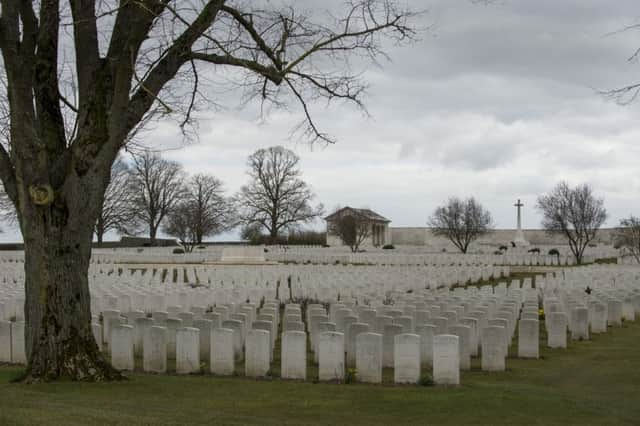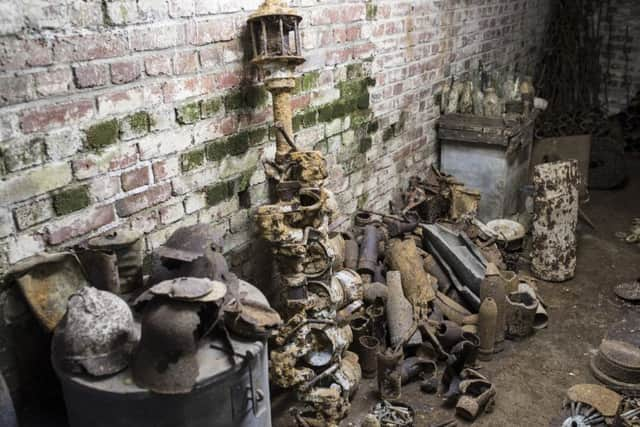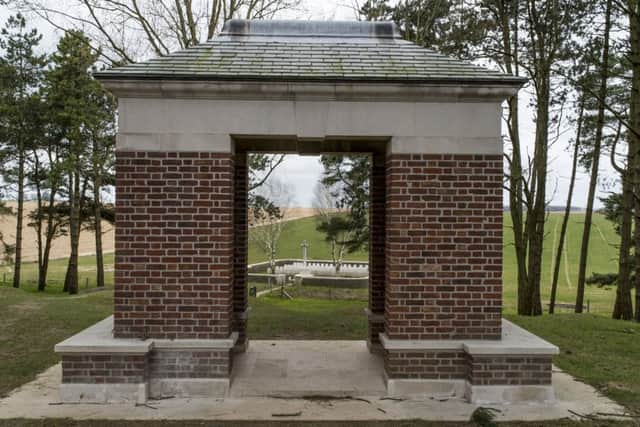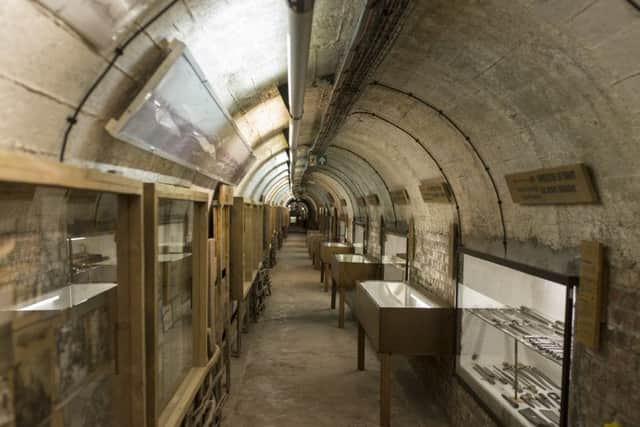Where Pals fell in killing fields


The Somme was where a generation of volunteers from Yorkshire’s industrial heartlands was snuffed out on July 1, 1916, leaving a county in shock and mourning for decades afterwards.
And here, at the Thiepval Memorial, towering 145ft high and commanding a hilltop overlooking a peaceful landscape that was once the scene of unimaginable carnage and suffering, is where the missing are commemorated.
Advertisement
Hide AdAdvertisement
Hide AdAmong them are the Yorkshire Pals – battalions of volunteers raised from factories, pits and offices in the heady early autumn of 1914 when Britain believed it would all be over by Christmas.


They were workmates, friends and neighbours, who drilled together and learned to be soldiers side by side over the course of a year-and-a-half. Then, side by side, they were slaughtered, many within moments of going over the top from their trenches.
Thiepval will be the focus of this summer’s formal Somme commemorations, where Prince Charles and Prince William will pay Britain’s respects alongside French president Francois Hollande.
The memorial is clad in scaffolding undergoing renovations ahead of the anniversary, the workmen on gantries high above ground weatherproofing it to resist the elements for the next 100 years.
Advertisement
Hide AdAdvertisement
Hide AdYet the work is being carried out so sympathetically to the memories of those it commemorates that the scaffolding gives way at the top to reveal the Union Flag and French Tricoleur flying together, as they have since the memorial was inaugurated in 1932.


On and on the Yorkshire names go, through panel after panel. The men it commemorates are not forgotten, as new generations pause to pay their respects.
The school parties that pass through, learning of the human cost of the Somme, leave tributes. Some are wreaths of poppies, others small wooden crosses bearing a poppy, like the one left by the staff and students of Honley High, in Huddersfield, in John Townend’s memory.
The fate of Yorkshire’s Pals battalions is one of the most poignant of all the sacrifices of the Great War.
Advertisement
Hide AdAdvertisement
Hide AdThe county responded with wild enthusiasm to the call to enlist and create new volunteer army. So many men flocked to recruiting offices that Barnsley and Bradford raised two battalions each. Leeds and Sheffield sent one each, and Hull raised four.


Miners from Charlesworth Colliery marched into Leeds to enlist, and formed the backbone of the Pioneers of the King’s Own Yorkshire Light Infantry, becoming known as T’Owd Twelfth.
In the city centre, vast crowds gathered in Boar Lane to see the Pals off as they marched to the railway station to leave for training, clapping each man on the shoulder as he passed and filling the streets with cheers. As the first trains left, the crowds sang It’s a Long Way to Tipperary.
March 1916 saw the Pals deployed to France. The build-up was under way for Field Marshal Sir Douglas Haig’s “big push” to break the German line at the River Somme.
Advertisement
Hide AdAdvertisement
Hide AdOne of his spearheads would be the 31st Division, made up of the Pals from Leeds, Hull, Bradford, Sheffield, Barnsley, Durham and Accrington, who would attack on the first day of the assault, July 1.


Their objective was the hilltop village of Serre, at the northern end of a 15-mile long front, and the assault was preceded by an artillery bombardment in which more than 1.6 million shells rained down on the German lines, with the aim of pulverising them.
It failed. The officers’ whistles went at 7am, sending the men over the top. The Accrington Pals went first and were cut to pieces.
At 7.20, the whistles went once more, and the Leeds Pals were the first Yorkshire battalion into action. The men of Barnsley, Bradford and Sheffield followed.
Advertisement
Hide AdAdvertisement
Hide AdThe machine gun fire, mortars and shelling confronting them was merciless. Wave after wave fell, some as they climbed out of the trenches, and survivors recalled that above the sound of battle arose a wail of agony from hundreds of the wounded and dying.
Only the mounting carnage saved the Hull Pals, who were held back as the scale of the slaughter and the futility of sending any more men over the top became apparent.
At the end of that terrible day, only 47 of the 650 Leeds Pals who went over the top survived. The 1st Bradford Pals lost 22 officers and 515 other ranks. The 2nd Bradford Pals lost 14 officers and 400 men. The Sheffield and Barnsley Pals lost half their strength. This was the single bloodiest day in British military history, with 54,470 casualties, including 19,240 killed.


Reminders of the Pals are everywhere in the immaculately-maintained Commonwealth War Graves Commission cemeteries that dot the landscape. But one place is especially potent – Sheffield Memorial Park, which marks the area where the Yorkshire trenches were. It is the most secluded and inaccessible of all the memorials – yet the one which is most vivid, for it lies on the spot where the young volunteers rose from their trenches at the blast of the officers’ whistles.
Advertisement
Hide AdAdvertisement
Hide AdAlmost hidden along a dusty farm track, the site has an extraordinary immediacy. It is wooded, just as it was then, the four small copses named by British commanders after the Gospels – Matthew, Mark, Luke and John.
And the ground bears the scars of battle – uneven, cratered, deformed and rutted by shellfire. In the shade of the trees, there is a black marble headstone commemorating the Barnsley Pals, and a simple brick shelter to remember the men of Sheffield. Alongside, as the men were in battle, stands the brick memorial to the Accrington Pals.
There is another memorial too, a concrete cross marking the spot where the remains of 22-year-old Albert Bull, a private from Apperknowle, near Sheffield, were found in 1928, 12 years after he vanished in the fighting of July 1. Half-a-mile away, his grave is in Serre Road Number 2 Cemetery, where he was so belatedly laid to rest alongside all the others in their late teens or early 20s.
A formal stone memorial to the Sheffield Pals stands alongside the main road through Serre, and the Leeds Pals are commemorated by a simple monument a few miles away in Bus-les-Artois.
Advertisement
Hide AdAdvertisement
Hide AdThe ghosts of the Pals linger all the way along the Somme battlefront. At Albert, in the Musée Somme 1916, housed in tunnels 30ft underground where civilians once sheltered from bombardments, a polished brass uniform insignia bears the single word Yorkshire.
A few miles away is the Lochnagar Crater, a 100ft deep chasm created by an explosion so powerful that it was heard in London, detonated under the German lines to obliterate defences and give the Pals the best chance of victory in the attack.
Like the bombardment before the whistles blew, it failed to prevent the carnage that befell Yorkshire’s young men that summer’s day a century ago.
Their loss was to scar the towns and cities that sent them for generations. JB Priestley, one of the volunteers of 1914 who rushed to enlist in his native Bradford along with all the others, might have been one of the victims of the Somme had he not been wounded a month before the battle and evacuated to England.
Advertisement
Hide AdAdvertisement
Hide AdLater, he reflected sadly on what it had cost Yorkshire. “There are many gaps in my acquaintance now; and I find it difficult to swap reminiscences of boyhood.
“The men who were boys when I was a boy are dead. Indeed they never even grew to be men. They were slaughtered in youth; and the parents of them have grown lonely, the girls they would have married have grown grey in sisterhood, and the work they would have done has remained undone.”
• See how The Yorkshire Post covered the start of the Battle of Somme by downloading this front page from the time. More of The YP coverage of the offensive is also available from www.britishnewspaperarchive.co.uk
• Andrew Vine and Mike Cowling travelled to the Somme courtesy of P&O Ferries (www.poferries.com) and Atout France (www.atout-france.fr).